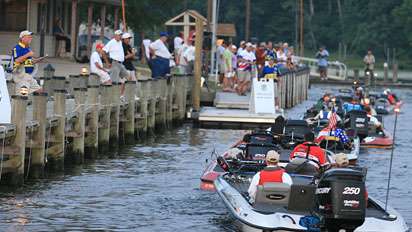
MARBURY, Md. — Mike McClelland glanced at the electronics on the front of his bass boat at 5:30 a.m. Thursday as he prepared for Day One of the Capital Clash presented by Advance Auto Parts. The water surface temperature on the Potomac River at Sweden Point Marina read 86 degrees.
"This place appears to be a lot different than it was a year ago," said McClelland, the Bella Vista, Ark., pro who finished eighth here last year. "I plan to fish moving water today once the tide starts falling."
McClelland thinks moving water might produce more active bass in the middle of the day when water surface temperatures hit 90-plus degrees.
McClelland was one of a handful of Bassmaster Elite Series contenders who spent most of their time last year 35 minutes south of the Smallwood State weigh-in site, concentrating on Nanjemoy Creek. He's going to try it again this morning, but isn't as confident, based on what he's seen in practice.
So what do bass do when the water gets this warm?
"Not a whole helluva lot," said Skeet Reese, who placed second by 7 ounces to champion Kelly Jordon in last year's Capital Clash.
Reese has a history of top performances on the Potomac River.
"I understand tides from growing up fishing the California Delta," Reese said. "There is a confidence factor here for me."
But even Reese wasn't excited about what he's found so far this week during practice.
"If I catch 13 pounds a day for three days, I'll be happy," Reese said.
His second-place total of 60 pounds, 2 ounces averaged 15 pounds for four days last year, but an average just over 13 pounds a day got Kevin Short (39-5) into the top six for the final day of competition.
And everybody thinks it's going to be tougher to catch bass this year. At least they did Thursday morning at the 6 a.m. first-flight launch.
"You never know," Paul Elias said. "We've had tournaments where no one catches them in practice, then everything changes during the tournament. But I didn't figure out anything during practice this week."
Ken Cook, a former Oklahoma fisheries biologists, says bass will feed during the day sometime, even if their primary feeding time now is at night.
"Their metabolism runs pretty high this time of year," Cook said. "It might not be for very long, but they'll be actively feeding sometime during the day. The key will be being at the right place at the right time.
"The rest of the day, I think it's going to come down to reaction strikes, like you get when you're punching grass with a big one-ounce or one-and-a-half ounce sinker. They may not be hungry, but they'll react to a fast-moving bait. They can't help themselves. It's just instinct."
Spinnerbaits, crankbaits and maybe even swimbaits might also produce that reaction strike in the warm waters of the Potomac River this week.
The first-day results will be apparent beginning at 3 p.m. ET Thursday at the Smallwood State Park weigh-in site near Sweden Point Marina. It is free and general public attendance is encouraged.
